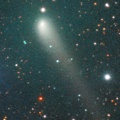
|
Now it is 8.9 mag (Feb. 21, Carlos Labordena). It stays bright as 8-9 mag until July. It is observable in good condition in the Northern Hemisphere. In the Southern Hemisphere, it is not observable until July.
Date(TT) R.A. (2000) Decl. Delta r Elong. m1 Best Time(A, h)
Feb. 29 2 8.52 61 10.2 1.738 1.840 79 8.7 19:18 (145, 46)
Mar. 7 2 13.87 62 28.0 1.756 1.798 76 8.6 19:24 (146, 43)
|
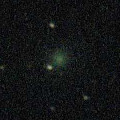
|
Now it is bright as 9.7 mag (Feb. 21, Carlos Labordena). It stays bright as 9 mag until late April. In the Northern Hemisphere, it stays observable for a long time, although it becomes extremely low in March. In the Southern Hemisphere, it is not observable until June when it fades down to 13 mag. It seems to be a fragment of C/1988 A1 (Liller), like C/1996 Q1 (Tabur) and C/2015 F3 (SWAN).
Date(TT) R.A. (2000) Decl. Delta r Elong. m1 Best Time(A, h)
Feb. 29 23 56.75 16 48.3 1.582 0.886 30 9.7 19:18 (104, 11)
Mar. 7 0 0.23 22 50.5 1.540 0.852 30 9.4 19:24 (113, 8)
|
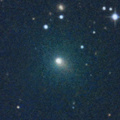
|
Brightening very rapidly. Now it is very bright as 11.5 mag (Feb. 28, Michael Jager). It moves along the same orbit as C/1844 Y1 (Great Comet). It approaches to Sun down to 0.25 a.u. on May 30. It is expected to brighten up to 1 mag. In the Northern Hemisphere, it stays observable in excellent condition until mid May when it brightens up to 5 mag. In the Southern Hemisphere, it is not observable until June.
Date(TT) R.A. (2000) Decl. Delta r Elong. m1 Best Time(A, h)
Feb. 29 11 6.02 57 59.7 1.236 2.019 129 11.1 0:36 (180, 67)
Mar. 7 10 38.96 61 54.5 1.173 1.906 123 10.6 23:34 (180, 63)
|
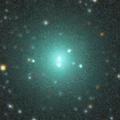
|
Now it is very bright as 10.6 mag (Feb. 21, Maik Meyer). It will be fading gradually after this. It is observable in good condition in the Northern Hemisphere. It is not observable in the Southern Hemisphere.
Date(TT) R.A. (2000) Decl. Delta r Elong. m1 Best Time(A, h)
Feb. 29 22 31.20 77 7.0 0.947 1.311 85 11.1 5:06 (195, 31)
Mar. 7 2 36.06 75 22.5 1.040 1.388 86 11.5 19:24 (163, 43)
|

|
Now it is 13.3 mag (Feb. 28, Sandor Szabo). It stays bright as 12-13 mag until summer. But it becomes low in spring. In the Southern Hemisphere, it will never be observable again.
Date(TT) R.A. (2000) Decl. Delta r Elong. m1 Best Time(A, h)
Feb. 29 23 56.04 46 39.0 3.736 3.301 56 12.5 19:18 (131, 25)
Mar. 7 0 2.14 48 0.7 3.800 3.324 54 12.6 19:24 (134, 22)
|
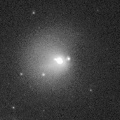
|
It brightened in outburst on Feb. 3. It is bright as 13.0 mag still now (Feb. 18, Toshihiko Ikemura, Hirohisa Sato). It is already unobservable in the Southern Hemisphere. It will be unobservable in mid March also in the Northern Hemisphere.
Date(TT) R.A. (2000) Decl. Delta r Elong. m1 Best Time(A, h)
Feb. 29 0 59.65 15 1.9 6.507 5.791 40 13.8 19:18 ( 93, 22)
Mar. 7 1 4.66 15 28.1 6.576 5.792 35 13.8 19:24 ( 98, 17)
|
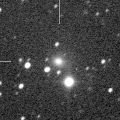
|
Now it is bright as 13.8 mag (Dec. 28, Chris Wyatt). It stays 14 mag until spring. It stays observable for a long time in the Southern Hemisphere. It is not observable until August in the Northern Hemisphere.
Date(TT) R.A. (2000) Decl. Delta r Elong. m1 Best Time(A, h)
Feb. 29 1 25.32 -58 49.8 3.934 3.533 59 14.3 19:18 ( 30,-19)
Mar. 7 1 34.67 -56 19.1 3.965 3.548 58 14.3 19:24 ( 35,-20)
|
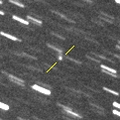
|
In the Southern Hemisphere, it is observable at 14.5 mag from winter to spring. In the Northern Hemisphere, it is not observable until August when it fades down to 17 mag.
Date(TT) R.A. (2000) Decl. Delta r Elong. m1 Best Time(A, h)
Feb. 29 1 52.58 -58 21.8 2.292 2.022 61 14.4 19:18 ( 28,-15)
Mar. 7 2 18.08 -53 33.1 2.311 2.032 61 14.4 19:24 ( 33,-13)
|
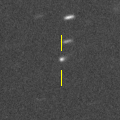
|
Now it is 14.9 mag (Feb. 22, Toshihiko Ikemura, Hirohisa Sato). It will brighten up to 13.5-14 mag from 2020 to 2021. It stays observable in good condition for a while.
Date(TT) R.A. (2000) Decl. Delta r Elong. m1 Best Time(A, h)
Feb. 29 13 14.86 14 42.5 2.565 3.405 142 14.7 2:43 ( 0, 70)
Mar. 7 13 12.23 15 20.9 2.502 3.388 148 14.6 2:13 ( 0, 70)
|
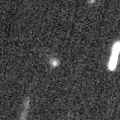
|
Now it is 15.2 mag (Feb. 20, Toshihiko Ikemura, Hirohisa Sato). It will brighten up to 10.5 mag from 2020 December to 2021 January. In the Northern Hemisphere, it stays observable in good condition while the comet will be brightening gradually, but it is not observable at the high light. In the Southern Hemisphere, it is not observable for a long time, but it will be observable in good condition after the high light.
Date(TT) R.A. (2000) Decl. Delta r Elong. m1 Best Time(A, h)
Feb. 29 18 41.64 66 5.7 3.650 3.715 86 15.0 5:06 (206, 49)
Mar. 7 18 43.73 67 35.7 3.577 3.650 86 14.9 4:57 (203, 50)
|

|
Now it is very bright as 14.4 mag (Feb. 14, Taras Prystavski). Taras Prystavski reported it has a coma of 1.5 arcmin. It will approach to Sun down to 0.9 a.u. in June, and it is extected to brighten up to 10 mag. In the Southern Hemisphere, it stays observable in good condition for a long time after this. In the Northern Hemisphere, it will be unobservable from late March to late June.
Date(TT) R.A. (2000) Decl. Delta r Elong. m1 Best Time(A, h)
Feb. 29 3 55.76 -25 58.8 2.021 2.017 75 15.6 19:18 ( 28, 23)
Mar. 7 3 57.90 -25 26.7 2.002 1.929 71 15.4 19:24 ( 35, 20)
|
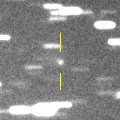
|
First return of a new periodic comet discovered in 2006. It brightened up to 14.9 mag in January (Jan. 21, R. Fichtl). It will never be observable after this.
Date(TT) R.A. (2000) Decl. Delta r Elong. m1 Best Time(A, h)
Feb. 29 0 8.58 -7 25.7 2.607 1.718 20 15.6 19:18 ( 82, -1)
Mar. 7 0 27.80 -5 57.8 2.614 1.708 19 15.6 19:24 ( 85, -3)
|
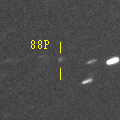
|
Now it is 15.8 mag (Feb. 23, Toshihiko Ikemura, Hirohisa Sato). Brightening very rapidly. It will brighten up to 8-9 mag from summer to autumn. It will be observable in excellent condition in the Southern Hemisphere. It locates very low around the high light in the Northern Hemisphere.
Date(TT) R.A. (2000) Decl. Delta r Elong. m1 Best Time(A, h)
Feb. 29 13 43.33 -5 33.3 1.657 2.446 133 15.9 3:12 ( 0, 49)
Mar. 7 13 42.67 -5 23.1 1.549 2.400 140 15.6 2:44 ( 0, 50)
|

|
Now it is 14.6 mag (Dec. 28, Chris Wyatt). It will be fading slowly after this. In the Southern Hemisphere, it becomes low from February to March, but it stays observable for a long time. In the Northern Hemisphere, it is not observasble until June.
Date(TT) R.A. (2000) Decl. Delta r Elong. m1 Best Time(A, h)
Feb. 29 23 15.27 -42 25.1 4.384 3.618 35 15.8 19:18 ( 57,-29)
Mar. 7 23 21.89 -40 55.1 4.410 3.651 35 15.9 19:24 ( 60,-33)
|
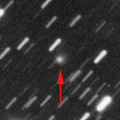
|
Now it is 15.4 mag (Feb. 20, Toshihiko Ikemura, Hirohisa Sato). It is expected to be observable at 5-6 mag for a long time from 2022 to 2023. In the Northern Hemisphere, it is not observable at the high light from 2022 summer to 2023 summer. In the Southern Hemisphere, it stays unobservable for a while. But it will be observable in good condition at the high light.
Date(TT) R.A. (2000) Decl. Delta r Elong. m1 Best Time(A, h)
Feb. 29 18 15.35 47 26.2 9.813 9.708 81 15.8 5:06 (235, 58)
Mar. 7 18 17.00 47 55.1 9.729 9.658 82 15.8 4:57 (233, 61)
|
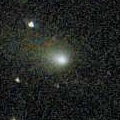
|
Now it is 15.5 mag (Feb. 18, Sandor Szabo). It will be fading after this, and will be fainter than 18 mag in May. In the Northern Hemisphere, it is observable in excellent condition. It locates low in the Southern Hemisphere.
Date(TT) R.A. (2000) Decl. Delta r Elong. m1 Best Time(A, h)
Feb. 29 4 52.19 14 10.9 1.251 1.646 93 15.8 19:18 ( 36, 65)
Mar. 7 5 9.15 13 30.8 1.325 1.667 90 16.1 19:24 ( 43, 63)
|
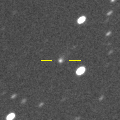
|
Now it is 16.1 mag (Feb. 20, Toshihiko Ikemura, Hirohisa Sato). It will brighten up to 13 mag in 2021. In 2020, it is observable at 15 mag in good condition from spring to summer.
Date(TT) R.A. (2000) Decl. Delta r Elong. m1 Best Time(A, h)
Feb. 29 15 2.26 -16 18.6 5.059 5.505 111 15.9 4:31 ( 0, 39)
Mar. 7 15 1.19 -16 47.7 4.912 5.462 118 15.8 4:02 ( 0, 38)
|

|
It brightened up to 7.7 mag in June in 2018 (June 19, Juan Jose Gonzalez). Now it is fading. It has already faded down to 15.8 mag (Feb. 18, Toshihiko Ikemura, Hirohisa Sato). In the Southern Hemisphere, it stays observable for a long time until the comet will fade out. In the Northern Hemisphere, it stays low for a while.
Date(TT) R.A. (2000) Decl. Delta r Elong. m1 Best Time(A, h)
Feb. 29 5 30.87 -23 0.9 5.883 6.091 97 15.9 19:18 ( 6, 32)
Mar. 7 5 30.37 -21 47.5 6.020 6.145 92 16.0 19:24 ( 15, 32)
|
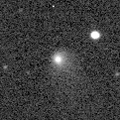
|
Now it is 14.8 mag (Dec. 28, Chris Wyatt). Fading slowly. Now it is not observable. It will appear in the morning sky in April in the Southern Hemisphere, or in June in the Northern Hemisphere.
Date(TT) R.A. (2000) Decl. Delta r Elong. m1 Best Time(A, h)
Feb. 29 23 41.72 -14 38.1 6.083 5.135 15 15.9 19:18 ( 79,-10)
Mar. 7 23 46.56 -13 33.7 6.138 5.172 12 16.0 19:24 ( 84,-16)
|
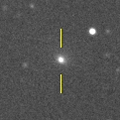
|
Now it is 15.9 mag (Feb. 18, Toshihiko Ikemura, Hirohisa Sato). It will be fading slowly after this.
Date(TT) R.A. (2000) Decl. Delta r Elong. m1 Best Time(A, h)
Feb. 29 2 1.62 8 17.5 2.864 2.381 51 16.3 19:18 ( 78, 31)
Mar. 7 2 14.44 9 35.3 2.937 2.392 48 16.4 19:24 ( 82, 28)
|
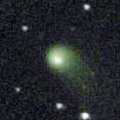
|
It will be fading slowly after this. In the Southern Hemisphere, it stays observable in good condition for a long time. It will never be observable after this in the Northern Hemisphere.
Date(TT) R.A. (2000) Decl. Delta r Elong. m1 Best Time(A, h)
Feb. 29 13 14.86 -75 14.3 4.774 4.939 93 16.3 2:45 ( 0,-20)
Mar. 7 12 45.39 -76 6.4 4.758 4.984 97 16.4 1:48 ( 0,-21)
|
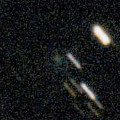
|
Now it is 16.6 mag (Feb. 19, Toshihiko Ikemura, Hirohisa Sato). It stays 16.5 mag until late March. It is not observable in the Southern Hemisphere.
Date(TT) R.A. (2000) Decl. Delta r Elong. m1 Best Time(A, h)
Feb. 29 1 43.10 22 46.2 1.821 1.465 53 16.3 19:18 ( 95, 35)
Mar. 7 2 3.48 25 43.2 1.864 1.479 52 16.4 19:24 (100, 34)
|
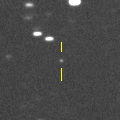
|
Now it is 15.9 mag (Feb. 18, Toshihiko Ikemura, Hirohisa Sato). It will brighten up to 16 mag in March, and it will be observable in good condition.
Date(TT) R.A. (2000) Decl. Delta r Elong. m1 Best Time(A, h)
Feb. 29 11 6.98 40 13.2 0.817 1.736 147 16.6 0:37 (180, 85)
Mar. 7 10 50.70 37 39.5 0.795 1.716 147 16.5 23:47 (180, 88)
|
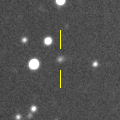
|
Now it is 16.4 mag (Feb. 23, Toshihiko Ikemura, Hirohisa Sato). It stays observable at 17 mag from 2020 to 2021. It locates somewhat low in the Northern Hemisphere.
Date(TT) R.A. (2000) Decl. Delta r Elong. m1 Best Time(A, h)
Feb. 29 10 51.07 -24 33.7 5.740 6.596 147 16.5 0:20 ( 0, 30)
Mar. 7 10 49.04 -24 8.3 5.715 6.593 150 16.5 23:46 ( 0, 31)
|
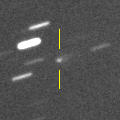
|
Now it is 16.8 mag (Feb. 18, Toshihiko Ikemura, Hirohisa Sato). It brightens up to 16.5 mag and will be observable in good condition from March to April.
Date(TT) R.A. (2000) Decl. Delta r Elong. m1 Best Time(A, h)
Feb. 29 13 33.28 -1 18.3 1.302 2.136 136 16.7 3:02 ( 0, 54)
Mar. 7 13 33.15 -1 4.4 1.258 2.141 143 16.6 2:34 ( 0, 54)
|
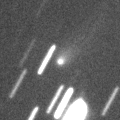
|
Now it is 16.2 mag (Jan. 21, Thomas Lehmann). The orbit is extremely hyperbolic with e=3.35. It is the first interstellar comet in history. It will be fading after this, and will be fainter than 18 mag in April. In the Southern Hemisphere, it is observable in excellent condition. In the Northern Hemisphere, it will never be observable again.
Date(TT) R.A. (2000) Decl. Delta r Elong. m1 Best Time(A, h)
Feb. 29 12 58.28 -65 33.9 2.316 2.708 102 16.7 2:27 ( 0,-11)
Mar. 7 12 57.18 -67 11.4 2.386 2.812 105 16.9 1:59 ( 0,-12)
|
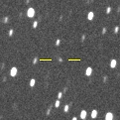
|
Now it is 17.2 mag (Feb. 20, Toshihiko Ikemura, Hirohisa Sato). It will stay at 14 mag for a long time from 2021 to 2022. In the Northern Hemisphere, it stays observable in good condition while brightening gradually. In the Southern Hemisphere, it will appear in the morning sky soon. But it stays locating low for a long time.
Date(TT) R.A. (2000) Decl. Delta r Elong. m1 Best Time(A, h)
Feb. 29 19 12.21 30 10.1 7.157 6.775 63 16.7 5:06 (260, 45)
Mar. 7 19 13.81 30 27.0 7.069 6.741 66 16.7 4:57 (262, 49)
|

|
It looks cometary on the LCO (CTIO) image on Aug. 21, 2019. Now it is 16.2 mag (Oct. 2, ATLAS-MLO, Mauna Loa). It is appearing in the mornign sky in the Southern Hemisphere. It will be observable in late March also in the Northern Hemisphere.
Date(TT) R.A. (2000) Decl. Delta r Elong. m1 Best Time(A, h)
Feb. 29 20 9.53 -30 54.4 7.213 6.521 42 16.7 5:06 (307, -2)
Mar. 7 20 10.50 -30 40.7 7.133 6.529 49 16.7 4:57 (310, 1)
|

|
Now it is 15.9 mag (Feb. 18, Toshihiko Ikemura, Hirohisa Sato). It will be fading gradually after this. It will be fainter than 18 mag in April.
Date(TT) R.A. (2000) Decl. Delta r Elong. m1 Best Time(A, h)
Feb. 29 8 55.38 8 48.1 2.239 3.154 152 16.7 22:20 ( 0, 64)
Mar. 7 8 52.08 9 18.9 2.319 3.186 145 16.9 21:50 ( 0, 64)
|
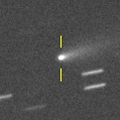
|
Now it is 16.0 mag (Feb. 17, Toshihiko Ikemura, Hirohisa Sato). It will fade out rapidly after this, and it will be fainter than 18 mag in late March.
Date(TT) R.A. (2000) Decl. Delta r Elong. m1 Best Time(A, h)
Feb. 29 11 20.75 15 58.5 1.149 2.129 168 16.8 0:50 ( 0, 71)
Mar. 7 11 16.59 16 29.5 1.186 2.168 168 17.1 0:18 ( 0, 71)
|

|
Now it is 17.8 mag (Feb. 20, Toshihiko Ikemura, Hirohisa Sato). It will be fading slowly after this, and will be fainter than 18 mag in 2021. It is observable in good condition in the Northern Hemisphere. In the Southern Hemisphere, it is observable in the extremely low sky only in 2021 spring.
Date(TT) R.A. (2000) Decl. Delta r Elong. m1 Best Time(A, h)
Feb. 29 13 22.90 55 42.3 8.140 8.719 123 17.2 2:51 (180, 69)
Mar. 7 13 19.58 55 55.7 8.146 8.729 123 17.2 2:20 (180, 69)
|
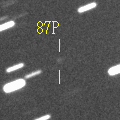
|
Now it is 17.4 mag (Feb. 20, Toshihiko Ikemura, Hirohisa Sato). It will brighten up to 17 mag and will be observable in excellent condition from March to May.
Date(TT) R.A. (2000) Decl. Delta r Elong. m1 Best Time(A, h)
Feb. 29 13 0.49 -6 33.9 1.287 2.163 143 17.4 2:29 ( 0, 48)
Mar. 7 12 59.87 -6 17.3 1.232 2.151 150 17.3 2:01 ( 0, 49)
|

|
Now it is 17.2 mag (Nov. 25, ATLAS-MLO). It brightened up to 14 mag from autumn to winter in 2018. Now it is fading. It is observable at 17.5 mag in good condition from winter to spring.
Date(TT) R.A. (2000) Decl. Delta r Elong. m1 Best Time(A, h)
Feb. 29 13 39.94 -3 18.2 3.747 4.501 134 17.5 3:08 ( 0, 52)
Mar. 7 13 35.85 -3 18.4 3.711 4.541 142 17.5 2:37 ( 0, 52)
|
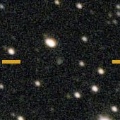
|
Now it is 17.8 mag (Feb. 23, Toshihiko Ikemura, Hirohisa Sato). It stays observable at 16.5 mag for a long time from 2020 to 2021. In the Northern Hemisphere, it is observable in excellent condition for a long time. In the Southern Hemisphere, it is not observable until 2021 summer.
Date(TT) R.A. (2000) Decl. Delta r Elong. m1 Best Time(A, h)
Feb. 29 1 3.76 69 55.7 6.552 6.479 81 17.5 19:18 (155, 39)
Mar. 7 1 7.68 69 10.6 6.608 6.460 77 17.5 19:24 (154, 36)
|

|
Now it is 17.8 mag (Feb. 17, Toshihiko Ikemura, Hirohisa Sato). It will brighten up to 13 mag in 2022. In 2020, it is observable at 17.5 mag in good condition in spring. It locates somewhat low in the Southern Hemisphere.
Date(TT) R.A. (2000) Decl. Delta r Elong. m1 Best Time(A, h)
Feb. 29 10 31.04 21 13.3 3.571 4.539 166 17.6 0:00 ( 0, 76)
Mar. 7 10 26.61 21 33.8 3.579 4.527 160 17.6 23:24 ( 0, 76)
|
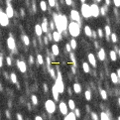
|
It will be observable at 16.5-17 mag from spring in 2020 to summer in 2021.
Date(TT) R.A. (2000) Decl. Delta r Elong. m1 Best Time(A, h)
Feb. 29 20 0.62 19 54.3 5.632 5.038 49 17.7 5:06 (266, 31)
Mar. 7 20 1.96 20 8.1 5.553 5.017 52 17.6 4:57 (268, 35)
|
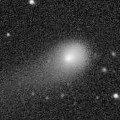
|
Fading. Now it is 18.3 mag (Feb. 18, Toshihiko Ikemura, Hirohisa Sato). It stays observable in good condition for a while.
Date(TT) R.A. (2000) Decl. Delta r Elong. m1 Best Time(A, h)
Feb. 29 7 54.67 23 27.5 6.395 7.146 136 17.7 21:20 ( 0, 78)
Mar. 7 7 50.34 23 17.0 6.530 7.191 128 17.8 20:48 ( 0, 78)
|
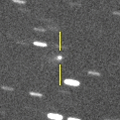
|
Fading. Now it is 18.0 mag (Feb. 26, Hidetaka Sato). It will be fainter than 18 mag soon.
Date(TT) R.A. (2000) Decl. Delta r Elong. m1 Best Time(A, h)
Feb. 29 17 39.94 -5 56.1 2.952 2.869 75 17.7 5:06 (319, 40)
Mar. 7 17 47.38 -5 15.0 2.909 2.913 80 17.8 4:57 (322, 42)
|

|
It will brighten up to 15.5 mag and will be observable in good condition from June to September.
Date(TT) R.A. (2000) Decl. Delta r Elong. m1 Best Time(A, h)
Feb. 29 18 37.82 -8 52.7 2.913 2.581 60 17.8 5:06 (307, 29)
Mar. 7 18 49.24 -7 56.7 2.812 2.555 64 17.7 4:57 (308, 31)
|
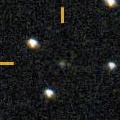
|
Now it is 17.5 mag (Feb. 18, Toshihiko Ikemura, Hirohisa Sato). It is observable at 17-18 mag for a long time from late 2019 to early 2021. It will fade out before it passes the perihelion.
Date(TT) R.A. (2000) Decl. Delta r Elong. m1 Best Time(A, h)
Feb. 29 3 4.89 5 58.3 5.287 4.973 66 17.8 19:18 ( 63, 42)
Mar. 7 3 8.92 6 35.9 5.371 4.960 60 17.8 19:24 ( 70, 37)
|

|
Now it is 17.6 mag (Feb. 18, Toshihiko Ikemura, Hirohisa Sato). It will be fainter than 18 mag in late April.
Date(TT) R.A. (2000) Decl. Delta r Elong. m1 Best Time(A, h)
Feb. 29 12 42.81 9 10.5 9.894 10.769 150 17.8 2:11 ( 0, 64)
Mar. 7 12 41.64 9 30.0 9.866 10.787 157 17.8 1:43 ( 0, 64)
|
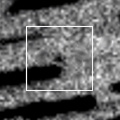
|
It is observable at 17.5 mag in good condition in spring.
Date(TT) R.A. (2000) Decl. Delta r Elong. m1 Best Time(A, h)
Feb. 29 17 33.85 -17 51.7 2.307 2.278 75 17.8 5:06 (328, 30)
Mar. 7 17 43.83 -17 51.1 2.250 2.305 80 17.8 4:57 (330, 31)
|
|
![]()
 390P/2019 U1 ( Gibbs )
390P/2019 U1 ( Gibbs ) 88P/Howell
88P/Howell C/2018 A6 ( Gibbs )
C/2018 A6 ( Gibbs ) C/2017 K2 ( PanSTARRS )
C/2017 K2 ( PanSTARRS ) 114P/Wiseman-Skiff
114P/Wiseman-Skiff C/2019 F1 ( ATLAS-Africano )
C/2019 F1 ( ATLAS-Africano ) C/2016 M1 ( PanSTARRS )
C/2016 M1 ( PanSTARRS ) C/2017 B3 ( LINEAR )
C/2017 B3 ( LINEAR ) 101P/Chernykh
101P/Chernykh C/2017 M4 ( ATLAS )
C/2017 M4 ( ATLAS ) 112P/Urata-Niijima
112P/Urata-Niijima 124P/Mrkos
124P/Mrkos C/2019 C1 ( ATLAS )
C/2019 C1 ( ATLAS ) P/2019 Y2 ( Fuls )
P/2019 Y2 ( Fuls ) 2I/2019 Q4 ( Borisov )
2I/2019 Q4 ( Borisov ) C/2018 U1 ( Lemmon )
C/2018 U1 ( Lemmon ) A/2017 U7
A/2017 U7 78P/Gehrels 2
78P/Gehrels 2 155P/Shoemaker 3
155P/Shoemaker 3 C/2010 U3 ( Boattini )
C/2010 U3 ( Boattini ) 87P/Bus
87P/Bus (944) Hidalgo
(944) Hidalgo C/2019 T3 ( ATLAS )
C/2019 T3 ( ATLAS ) 117P/Helin-Roman-Alu 1
117P/Helin-Roman-Alu 1 C/2017 Y2 ( PanSTARRS )
C/2017 Y2 ( PanSTARRS ) C/2015 O1 ( PanSTARRS )
C/2015 O1 ( PanSTARRS ) C/2019 F2 ( ATLAS )
C/2019 F2 ( ATLAS ) 257P/Catalina
257P/Catalina 173P/Mueller 5
173P/Mueller 5 C/2014 B1 ( Schwartz )
C/2014 B1 ( Schwartz ) 175P/Hergenrother
175P/Hergenrother![]()





































